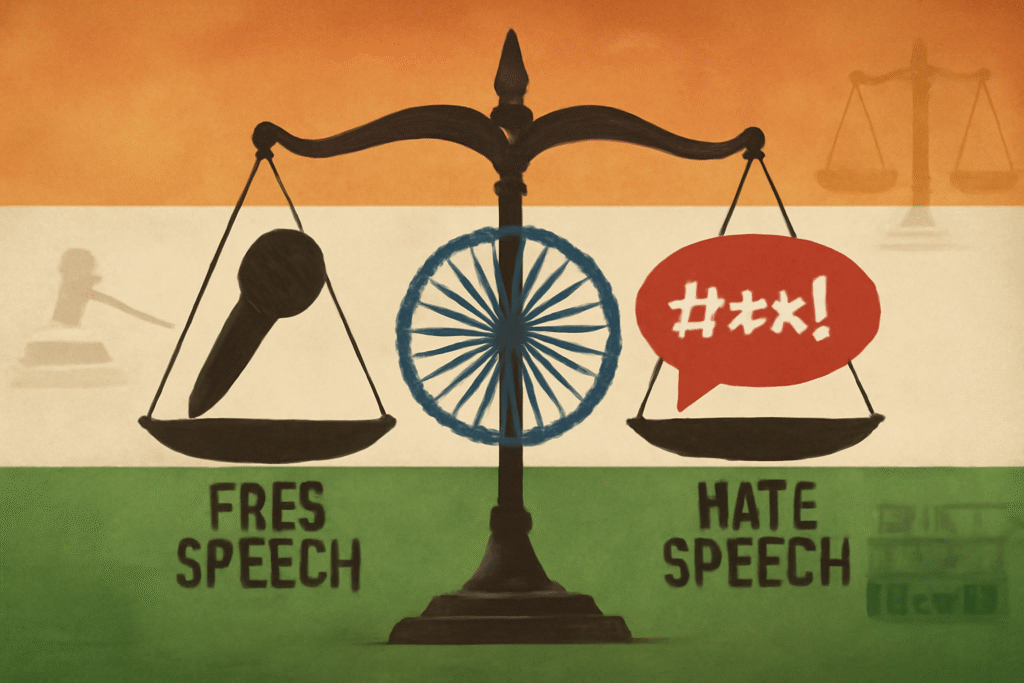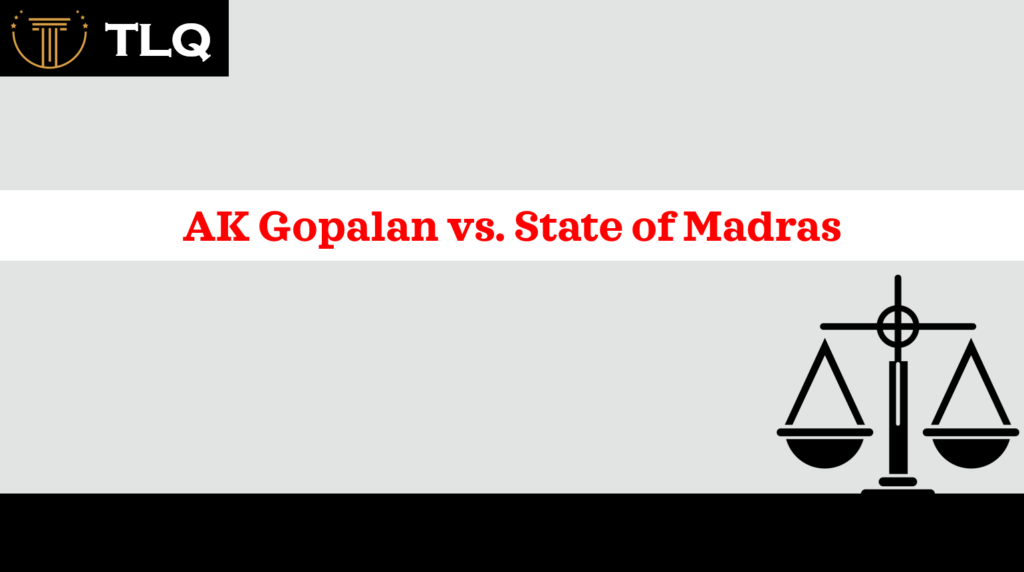Published on 21st June 2025
Authored By: Vaida Jaasmita
Vellore Institute of Technology, Chennai
Abstract
The concept of right to fair trial has been emerging as one of the major challenges to the criminal jurisprudence. Where media is considered to be fourth pillar of democracy and in the era of sensational journalism the application of “trial by media” in judicial matters has dangerously impacted the public sphere into public lynching. This article sheds light on how the media trials endangers the right to fair trial with valid constitutional provisions, judicial precedents and global understandings. The article argues the absence of balances and checks on media poses direct threat on the integrity and sovereignty of the justice system and its frameworks of freedom of speech and expression and fair trial.
Introduction
In democracy, media being the fourth pillar plays a vital role as a guard where the idea of “trial by media” means a situation where the media publishes opinions or information about a case that prejudices the outcome of judicial proceedings by informing the public, exposing corruption, and holding the power to account. However, with the rise in 24/7 news cycles, social media virality, and TRP- driven makes this problematic where the media narratives shifted from reporting facts to delivering opinions disguised as news without evidence, burden of proof, or procedural fairness and often assumes the role of prosecutor, judge and executioner. All these are essentials to ensure fair trial.[1]
Constitutional Provisions and Doctrines
Freedom of the Press vs. Right to Fair Trial: The Indian Constitution envisages both Freedom of Speech and Expression under Article 19(1)(a) and the Right to Life and Personal Liberty ensures Right to Fair Trial under Article 21[2].
The freedom of press is a fundamental feature of a democratic society, but it is not an absolute right.[3] Under Article 19(2) it states reasonable restrictions on freedom of speech and expression when it threatens the interest of sovereignty of India, public order, contempt of court, defamation, unity etc.[4] Under Article 21 the right to fair trial is not mentioned explicitly but is read through judicial interpretation.
Where in the case of Maneka Gandhi v. Union of India (1978), the Supreme Court held that procedure established by law must be just, fair and reasonable.[5] However, sometimes the media and press exercise this freedom in a way that it jeopardizes the legal proceedings.
Contempt of Court and the Sub Judice Rule: Any action that “scandalizes” or has the potential to taint legal proceedings may be deemed contempt under the Contempt of Courts Act, 1971.[6] India does not have legislation enforcing the well-known sub judice rule, which prohibits public discussion of ongoing legal matters in order to protect the integrity of the legal system.
Nonetheless, media organizations continue to do “investigative journalism” on cases that are still pending in court, often revealing unverified information, selectively leaking information, and showcasing biased images—all of which are in direct opposition to the administration of justice.
Media Trial: Mechanism and Impact
Breaking news, immediate judgment, public outrage, character assassination, parallel trial, and legal intervention are typically the first steps in a media trial. Experts and anchors make judgments based on insufficient information, which taints the legal system and leads to boycotts and memes.
Publicized cases render the golden thread of criminal law—that which is innocence until proven guilty— useless. These cases might also affect influence or intimidation of witnesses. As Justice V.R. Krishna Iyer said, “even an acquittal cannot undo the harm media designation causes to society”[7].
Key Judicial Precedents
The Indian judiciary has acknowledged the dangers of unrestricted media participation in a number of rulings. The court issued postponement orders in Sahara India Real Estate Corp. v. SEBI (2012)[8], stating that the right to a fair trial must not be compromised by media freedom. The Delhi High Court ruled in R.K. Anand v. Registrar (2009)[9] that while the media may expose misconduct, they cannot impede the course of justice or sway witnesses. A trial by the press is contrary to the rule of law, the court ruled in State of Maharashtra v. Rajendra Jawanmal Gandhi (1997)[10], rejecting public and media-driven pressure campaigns on courts. The court noted in Romila Thapar v. Union of India (2018)[11] that media narratives have the power to present an “alternate truth” and disparage accused people before a court has a chance to hear the case.
Media Trials in High-Profile Cases
The Murder of Aarushi Talwar (2008): The media disseminated rumours and theories that lacked solid evidence. Years after being repeatedly attacked, the Talwar family was found not guilty. The media was accused by the Allahabad High Court of causing irreparable harm to the public’s reputation.[12]
The 1999 Murder Case of Jessica Lal: A case that was headed toward acquittal was saved thanks in large part to the media. But it also brought up uncomfortable questions about selective media activism: are “high-profile victims” the only ones who receive justice?[13]
The case of Sushant Singh Rajput (2020): Arguments on television turned into witch hunts in public. Those who were detained by the Narcotics Control Bureau were later released, but not before the media labelled them criminals. The actions of the media were condemned by the Bombay High Court as “completely against journalistic ethics.”[14]
International Provisions
Under the Contempt of Court Act of 1981, the UK enforces the “strict liability rule,” which penalizes publications that seriously injure people or obstruct legal proceedings.[15] US courts have the authority to sequester juries, hold in-camera trials, and impose gag orders in order to limit media influence, even in the face of strong First Amendment protections. Because of too much media coverage, the US Supreme Court reversed a murder conviction in 1966.[16] According to Article 6 of the European Convention, the press cannot violate the rights of the accused, the European Court of Human Rights emphasized.[17]
Theoretical and Doctrinal Critique
The legal burden is often reversed, requiring the accused to prove their innocence in public, according to the text, which attacks media coverage of legal issues. It also criticizes the significance of public opinion in judicial decision-making and the Audi Alteram Partem principle, which allows opposing parties to be heard in trials.[18] According to the essay’s conclusion, justice should be perceived as being administered by a capable court rather than by means of public discussion, which undermines the legitimacy of the legal system.
Criticism
India’s enforcement of media excesses is weak and dispersed; for example, the Press Council of India lacks the authority to punish, the Cable Television Networks (Regulation) Act of 1995 is unclear about subjudice reporting, and the Information Technology Act of 2000 regulates content but hardly ever protects trial rights. Furthermore, the absence of a legally binding code of conduct for courtroom reporting in India undermines public trust in the judiciary.
Justice D.Y. Chandrachud emphasized the distinction between press freedom and media trial, stating that the latter undermines public trust in the judiciary.[19]
Recommendations
Until Parliament enacts legislation, the Supreme Court may establish judicial guidelines under Article 142. Court reporting must be governed by a legally binding code that includes sanctions for infractions. High-profile cases should be expedited by courts to prevent drawn-out trials. By amending the PCI Act to give it adjudicatory and penal authority, the Press Council should be strengthened. Legal literacy initiatives on the right to a fair trial and public awareness campaigns about the difference between sensationalism and factual news should be encouraged. Journalism schools should teach students about court procedures and constitutional ideals to prevent careless reporting.
Conclusion
Democracy cannot exist without a free press, but in the absence of accountability, it can degenerate into anarchy. The media and the judiciary must coexist without interfering with one another’s constitutional duties. In the face of public outrage, courts cannot administer justice, and the media cannot argue that their violations of legal rights are in the public interest. Justice ought to be a solemn legal process founded on procedure, facts, and well-reasoned judgment. It is morally and legally required to oppose media trials.
References
[1] Fair Trial, EBSCO Research Starters, https://www.ebsco.com/research-starters/law/fair-trial
[2] INDIA CONST. art. 19(1)(a); art. 21.
[3] Freedom of Speech, Principles of Democracy, https://www.principlesofdemocracy.org/speech-dem
[4] INDIA CONST. art. 19(2)
[5] Maneka Gandhi v. Union of India, (1978) 1 SCC 248.
[6] The Contempt of Courts Act, No. 70 of 1971.
[7] V.R. Krishna Iyer, quoted in R. Ramachandran, Media and the Courts, 45(12) ECON. & POL. WKLY. 24 (2010).
[8] Sahara India Real Estate Corp. v. SEBI, (2012) 10 SCC 603.
[9] R.K. Anand v. Registrar, Delhi High Court, (2009) 8 SCC 106.
[10] State of Maharashtra v. Rajendra Jawanmal Gandhi, (1997) 8 SCC 386.
[11] Romila Thapar v. Union of India, (2018) 10 SCC 753.
[12] Dr. Rajesh Talwar v. CBI, Criminal Appeal No. 680/2018 (All. HC).
[13] Jessica Lal Murder Case, The Hindustan Times, May 2006.
[14] Sameet Thakkar v. State of Maharashtra, WP (Cr.) 1786/2020 (Bom. HC).
[15] Contempt of Court Act, 1981, c. 49 (UK).
[16] Sheppard v. Maxwell, 384 U.S. 333 (1966).
[17] European Convention on Human Rights, art. 6, Nov. 4, 1950, 213 U.N.T.S. 221.
[18] Andrew Faught, Judicial Decision-Making, Emory Lawyer, Summer 2024, https://law.emory.edu/lawyer/issues/2024/summer/features/judicial-decision-making/index.html
[19] D.Y. Chandrachud, Speech on Media Trials and Justice, (2021), https://www.sci.gov.in (last visited May 10, 2025).


![Detailed Case Commentary of Joseph Shrine v. Union of India [2018] 11SCR770](https://thelegalquorum.com/wp-content/uploads/2024/11/DALL·E-2024-11-08-01.30.57-A-clear-refined-and-professional-image-on-the-topic-Marital-Rape_-Legal-Lacunae-and-Need-to-Reform.-The-image-shows-a-formal-courtroom-scene-with-1-1-1024x585.webp)

